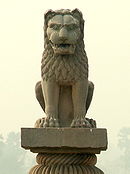- Niddesa
-

Countries
Sri Lanka
Cambodia • Laos
Burma • ThailandHistory
Pre-sectarian Buddhism
Early schools • Sthavira
Asoka • Third Council
Vibhajjavada
Mahinda • Sanghamitta
Dipavamsa • Mahavamsa
BuddhaghosaDoctrine
Saṃsāra • Nibbāna
Middle Way
Noble Eightfold Path
Four Noble Truths
Enlightenment Stages
Precepts • Three Jewels
Outline of BuddhismThe Niddesa (abbrev., "Nidd") is a Buddhist scripture, part of the Pali Canon of Theravada Buddhism. It is included there in the Sutta Pitaka's Khuddaka Nikaya. It is in the form of a commentary on parts of the Suttanipata. The tradition ascribes it to the Buddha's disciple Sariputta. It is divided into two parts:
- Maha Niddesa (mahā-) (abbrev., "Nidd I" or "Nd1"), commenting on the Atthaka Vagga ("Octet Chapter," Sn 4);
- Culla or Cula Niddesa (cūḷa-) (abbrev., "Nidd II" or "Nd2"), commenting on the Parayana Vagga ("Way to the Far Shore Chapter,"Sn 5) and Khaggavisana Sutta ("Rhinoceros Horn Discourse," Sn 1.3).
This text is believed to have been most likely composed no later than the 1st c. BC.[1]
Contents
References
- ^ Hinüber (2000), p. 59, para. 118, writes:
- The age of Nidd has been discussed at great length by S.Lévi 1925, who arrives at a date in the 2nd century AD, arguing from the geographical horizon of the text. This date has been disputed recently by Norman 1983: 84,86, who argues in favour of a much earlier date at the time of Aśoka. The question needs reexamination. It is, however, certain that Nidd does not belong to the old canonical texts and that also a date after Aśoka does not seem likely.
- But "cannot be later than the date of the fixing of the canon", Norman:Sn-trsl II, p. XXVI: This means not later than 1st century BC.
Sources
- Hinüber, Oskar von (2000). A Handbook of Pāli Literature. Berlin: Walter de Gruyter. ISBN 3-11-016738-7.
- Access to Insight: http://www.accesstoinsight.org/tipitaka/kn/index.html
External links
- Link to a small excerpt from the Niddesa that has been translated into English:[1]
See also
- Atthakavagga and Parayanavagga
- Khaggavisana Sutta
- Sutta Nipata
Buddhism topics Foundations Three Jewels (Buddha · Dharma · Sangha) · Four Noble Truths · Noble Eightfold Path · Nirvana · Middle Way
The Buddha Key concepts Three Marks of Existence: (Impermanence · Suffering · Not-self) · Dependent Origination · Five Aggregates · Karma · Rebirth · Saṃsāra · Saṅkhāra · Defilements · Ignorance · Craving · Five Hindrances · Ten Fetters · Faculties · Enlightenment (Awakening) · Parinirvana · Thusness · Two truths doctrine · Emptiness · Bodhicitta · Bodhisattva · Buddha-nature · Mindstream · Dzogchen
Cosmology Practices Refuge · Buddhist devotion · Puja: (Offerings · Prostration · Chanting) · Merit · Paritta · Generosity · Renunciation · Morality: (Precepts · Bodhisattva vows · Patimokkha) · Threefold Training: (Morality · Concentration · Wisdom) · Four Divine Abidings: (Loving-kindness · Compassion · Sympathetic joy · Equanimity) · Perfections · Enlightenment Qualities · Seven Factors of Enlightenment · Bases of Power · Five Strengths · Faith · Effort (Four Right Exertions) · Mindfulness (Satipatthana) · Jhāna (Dhyāna) · Bhavana · Meditation: (Kammaṭṭhāna · Recollection · Smarana · Mindfulness of Breathing · Serenity meditation · Insight meditation · Shikantaza · Zazen · Kōan · Mandala · Tonglen · Tantra · Tertön · Terma)
Attainment Types of Buddha · Private Buddha · Bodhisattva · Four stages of enlightenment: (Stream-enterer · Once-returner · Non-returner · Arahant)
Monasticism Monk · Nun · Novice monk · Novice nun · Anagarika · Ajahn · Sayadaw · Zen master · Rōshi · Lama · Rinpoche · Geshe · Tulku · Householder · Lay follower · Disciple
Major figures Gautama Buddha · Sāriputta · Mahamoggallāna · Ananda · Maha Kassapa · Anuruddha · Mahakaccana · Nanda · Subhuti · Punna · Upali · Mahapajapati Gotami · Khema · Uppalavanna · Buddhaghosa · Nagasena · Bodhidharma · Nagarjuna · Asanga · Vasubandhu · Atisha · Padmasambhava · Dalai Lama
Texts Branches Lands History Philosophy Abhidharma · Logic · Buddhology · Eschatology · Reality · God · Humanism · Engaged Buddhism · Socialism · Anarchism · Economics · Atomism · Evolution · Ethics · Fourteen unanswerable questions
Culture Art · Greco-Buddhist art · Poetry · Buddha statue · Budai · Symbolism: (Dharmacakra · Flag · Bhavacakra · Thangka) · Prayer wheel · Mala · Mudra · Mantra (Om mani padme hum) · Music · Holidays: (Vesak · Uposatha · Magha Puja · Asalha Puja · Rains retreat) · Monastic robe · Architecture: (Vihara · Wat · Stupa · Pagoda · Thai temple art and architecture) · Pilgrimage: (Lumbini · Bodh Gaya · Sarnath · Kushinagar) · Bodhi Tree · Mahabodhi Temple · Calendar · Cuisine · Vegetarianism
Miscellaneous Lineage · Maitreya · Avalokiteśvara (Guan Yin) · Amitābha · Brahmā · Māra · Dhammapada · Vinaya · Sutra · Hinayana · Liturgical languages: (Pali · Sanskrit) · Dharma talk · Kalpa · Higher Knowledge · Supernormal Powers
Buddhism and: Science · Psychology · Hinduism · Jainism · East Asian religions · Christianity · Theosophy · Gnosticism
Lists Categories:- Khuddaka Nikaya
- Buddhism stubs
Wikimedia Foundation. 2010.
